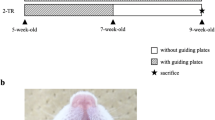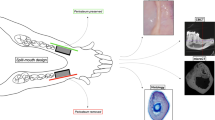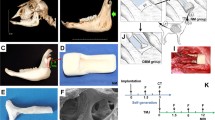Abstract
Objectives
This study was aimed at resolving the controversy over the wearing time of mandibular advancement (MA) appliances by comparing the differences between part-time and full-time MA (PTMA and FTMA) from the perspective of promoting H-type vessel coupling osteogenesis in the condylar heads.
Materials and methods
Thirty 30-week-old male C57BL/6J mice were randomly divided into 3 groups: the control (Ctrl), PTMA, and FTMA groups. The mandibular condyles were analyzed by morphology, micro-computed tomography, histological staining, and immunofluorescence staining to investigate the changes of the condylar heads in the PTMA and FTMA groups after 31 days.
Results
Both PTMA and FTMA models promoted condylar growth and achieved stable mandibular advancement at day 31. However, compared with PTMA, FTMA has the following characteristics. First, new bone formation in the condylar head was detected in the retrocentral region in addition to the posterior region. Second, the condylar proliferative layer was thicker, and the number of pyknotic cells in the hypertrophic and erosive layers was higher. Moreover, endochondral osteogenesis of the condylar head was more active. Finally, the retrocentral and posterior regions of the condylar head had more vascular loops or arcuate H-type vessel coupling Osterix+ osteoprogenitors.
Conclusions
While both PTMA and FTMA induced new bone formation in the condylar heads of middle-aged mice, FTMA promoted more osteogenesis by volume and region. Furthermore, FTMA presented more H-type vessel coupling Osterix+ osteoprogenitors in both the retrocentral and posterior regions of the condylar head.
Clinical relevance
FTMA is better at promoting condylar osteogenesis, especially in non-growing patients. We suggest that enhancing H-type angiogenesis could be an effective strategy to achieve favorable MA outcomes, especially for patients unable to meet the FT-wearing requirement or being non-growing.




Similar content being viewed by others
Data availability
The data used to support the findings of this study are included within the article.
References
Tümer N, Gültan AS (1999) Comparison of the effects of monoblock and twin-block appliances on the skeletal and dentoalveolar structures. Am J Orthod Dentofacial Orthop 116:460–468. https://doi.org/10.1016/s0889-5406(99)70233-7
Clark WJ (1988) The twin block technique. A functional orthopedic appliance system. Am J Orthod Dentofacial Orthop 93:1–18. https://doi.org/10.1016/0889-5406(88)90188-6
Li H, Ren X, Hu Y, Tan L (2020) Effects of the Forsus fatigue-resistant device on skeletal class II malocclusion correction. J Contemp Dent Pract 21:105–112
Amuk M, Gul Amuk N, Yılmaz S (2022) Treatment and posttreatment effects of Herbst appliance therapy on trabecular structure of the mandible using fractal dimension analysis. Eur J Orthod 44:125–133. https://doi.org/10.1093/ejo/cjab048
Cozza P, Baccetti T, Franchi L, De Toffol L, McNamara JA Jr (2006) Mandibular changes produced by functional appliances in class II malocclusion: a systematic review. Am J Orthod Dentofacial Orthop 129:599.e591–599.e512; discussion e591-596. https://doi.org/10.1016/j.ajodo.2005.11.010
Santamaría-Villegas A, Manrique-Hernandez R, Alvarez-Varela E, Restrepo-Serna C (2017) Effect of removable functional appliances on mandibular length in patients with class II with retrognathism: systematic review and meta-analysis. BMC Oral Health 17:52. https://doi.org/10.1186/s12903-017-0339-8
Parekh J, Counihan K, Fleming PS, Pandis N, Sharma PK (2019) Effectiveness of part-time vs full-time wear protocols of Twin-block appliance on dental and skeletal changes: a randomized controlled trial. Am J Orthod Dentofacial Orthop 155:165–172. https://doi.org/10.1016/j.ajodo.2018.07.016
Kutay C, Kılıçoğlu H, Sayar G (2021) Comparison of objective wear time between monoblock and twin-block appliances measured by microsensor. Angle Orthod 91:749–755. https://doi.org/10.2319/021421-128.1
Frilund E, Sonesson M, Magnusson A (2022) Patient compliance with Twin Block appliance during treatment of class II malocclusion: a randomized controlled trial on two check-up prescriptions. Eur J Orthod. https://doi.org/10.1093/ejo/cjac046
Arponen H, Hirvensalo R, Lindgren V, Kiukkonen A (2020) Treatment compliance of adolescent orthodontic patients with headgear activator and twin-block appliance assessed prospectively using microelectronic wear-time documentation. Eur J Orthod 42:180–186. https://doi.org/10.1093/ejo/cjaa001
Clark WJ (2019) Twin Blocks designed for 24-hour wear. Am J Orthod Dentofacial Orthop 156:295. https://doi.org/10.1016/j.ajodo.2019.05.006
Peter E, Monisha J, Baiju RM, Narayan V, Ani S (2019) Part-time vs full-time wear of Twin-block appliance: can we rejoice? Am J Orthod Dentofacial Orthop 156:295–296. https://doi.org/10.1016/j.ajodo.2019.05.007
González Espinosa D, Santos M, Mendes S, Normando D (2020) Mandibular propulsion appliance for adults with class II malocclusion: a systematic review and meta-analysis. Eur J Orthod 42:163–173. https://doi.org/10.1093/ejo/cjz089
Kusumbe AP, Ramasamy SK, Adams RH (2014) Coupling of angiogenesis and osteogenesis by a specific vessel subtype in bone. Nature 507:323–328. https://doi.org/10.1038/nature13145
Li H, Liao L, Hu Y, Xu Y, Zhang Y, Huo F, Tian W, Guo W (2021) Identification of type H vessels in mice mandibular condyle. J Dent Res 100:983–992. https://doi.org/10.1177/00220345211002120
Ellacott KL, Morton GJ, Woods SC, Tso P, Schwartz MW (2010) Assessment of feeding behavior in laboratory mice. Cell Metab 12:10–17. https://doi.org/10.1016/j.cmet.2010.06.001
Wang S, Ye L, Li M, Zhan H, Ye R, Li Y, Zhao Z (2018) Effects of growth hormone and functional appliance on mandibular growth in an adolescent rat model. Angle Orthod 88:624–631. https://doi.org/10.2319/120417-829.1
Gong FF, Feng J, Hu Z, Shen G, Chen RJ, You QL (2011) Effect of semi-fixed Twin-block appliance on temporomandibular joint remodeling. Shanghai Kou Qiang Yi Xue 20:409–412
Xiong H, Rabie AB, Hagg U (2005) Mechanical strain leads to condylar growth in adult rats. Front Biosci 10:67–73
Xiong H, Rabie AB, Hagg U (2005) Neovascularization and mandibular condylar bone remodeling in adult rats under mechanical strain. Front Biosci 10:74–82. https://doi.org/10.2741/1508
Tang Y, Hong C, Cai Y, Zhu J, Hu X, Tian Y, Song X, Song Z, Jiang R, Kang F (2020) HIF-1α mediates osteoclast-induced mandibular condyle growth via AMPK signaling. J Dent Res 99:1377–1386. https://doi.org/10.1177/0022034520935788
Shen G, Darendeliler MA (2005) The adaptive remodeling of condylar cartilage---a transition from chondrogenesis to osteogenesis. J Dent Res 84:691–699. https://doi.org/10.1177/154405910508400802
Rabie AB, Xiong H, Hägg U (2004) Forward mandibular positioning enhances condylar adaptation in adult rats. Eur J Orthod 26:353–358. https://doi.org/10.1093/ejo/26.4.353
Hu Y, Li H (2022) Biological mechanism of surgery-mediated acceleration of orthodontic tooth movement: a narrative review. J Int Med Res 50:3000605221123904. https://doi.org/10.1177/03000605221123904
Raposo R, Peleteiro B, Paço M, Pinho T (2018) Orthodontic camouflage versus orthodontic-orthognathic surgical treatment in class II malocclusion: a systematic review and meta-analysis. Int J Oral Maxillofac Surg 47:445–455. https://doi.org/10.1016/j.ijom.2017.09.003
Hu Y, Li H (2023) Deferoxamine mesylate enhances mandibular advancement-induced condylar osteogenesis by promoting H-type angiogenesis. J Oral Rehabil 50:234–242. https://doi.org/10.1111/joor.13410
Funding
This work was supported by Scientific Research Talent Cultivation Project of Stomatological Hospital, Southern Medical University (Grant Number RC202106 and RC202107), and Guangdong Basic and Applied Basic Research Fund (Grant Number 2021A1515110163).
Author information
Authors and Affiliations
Contributions
Both authors contributed to the conception, design, data acquisition, analysis, and interpretation. The first draft of the manuscript was written by Yun Hu. Reviewing and editing were performed by Hegang Li. Both authors read and approved the final manuscript.
Corresponding author
Ethics declarations
Ethical approval
All animal experiments in this study have been approved by the Animal Ethical and Welfare Committee of Guangzhou Forevergen Medical Laboratory Animal Center (Approval No. IACUC-AEWC-F2112009).
Competing interests
The authors declare no competing interests.
Additional information
Publisher’s note
Springer Nature remains neutral with regard to jurisdictional claims in published maps and institutional affiliations.
Rights and permissions
Springer Nature or its licensor (e.g. a society or other partner) holds exclusive rights to this article under a publishing agreement with the author(s) or other rightsholder(s); author self-archiving of the accepted manuscript version of this article is solely governed by the terms of such publishing agreement and applicable law.
About this article
Cite this article
Hu, Y., Li, H. Comparison of part-time and full-time mandibular advancement: enlightenment based on type H vessel coupling osteogenesis. Clin Oral Invest 27, 3695–3703 (2023). https://doi.org/10.1007/s00784-023-04985-5
Received:
Accepted:
Published:
Issue Date:
DOI: https://doi.org/10.1007/s00784-023-04985-5




